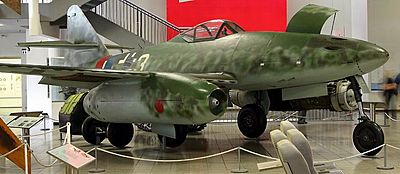Luftwaffe facts for kids
Quick facts for kids Luftwaffe |
|
|---|---|
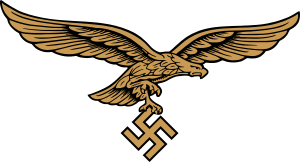
Emblem of the Luftwaffe (variant)
|
|
| Active | 1933–1946 |
| Country | |
| Allegiance | |
| Type | Air force |
| Role | Aerial warfare |
| Size | Aircraft 119,871 (total production) Personnel 3,400,000 (total in service at any time for 1939–45) |
| Part of | Wehrmacht |
| Engagements | Spanish Civil War World War II |
| Insignia | |
| Balkenkreuz (fuselage and wing undersurfaces) | 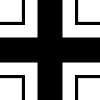 |
| Balkenkreuz (upper wing surfaces) |  |
| Swastika (fin flash 1939–1945, white border omitted during late war) | 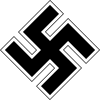 |
The Luftwaffe is the name for the air force of Germany. It has been the name for Germany's air force at different times in history. This includes the period when Adolf Hitler was in power (1933-1945) and during the Cold War (1955-1990) when Germany was split into two countries: East Germany and West Germany. Since 1990, when Germany became one country again, the Luftwaffe has been the air force of the united Germany. The word "Luftwaffe" simply means "Air Force" in German.
Contents
Early Days of German Air Power

Germany first used airplanes in its army in 1910. This was four years before World War I began in 1914. Back then, airplanes did not have guns. They were used for reconnaissance, which means flying over battlefields to see what the enemy was doing. Pilots would then report back to their generals. This information helped generals plan their attacks. Before airplanes, balloons were used for similar tasks.
Airplanes in World War I
During World War I, Germany used different types of airplanes. These included fighters, bombers, and reconnaissance planes. The fighter planes became very famous because of their brave pilots. The most well-known German pilot of World War I was Manfred von Richthofen, often called "The Red Baron."
Germany also used large airships known as "Zeppelins." These were named after Count Ferdinand von Zeppelin, who built the first airships in 1900. He originally wanted them to carry goods and passengers, not bombs. Even though he died in 1917, his name is still used for these German airships. The Zeppelin company still makes airships today, though they are much smaller.
After World War I
In November 1918, the "Allies" (including Britain and France) won World War I. Germany had to sign the Treaty of Versailles. This treaty stated that Germany was not allowed to have any military airplanes. This was a punishment because Germany was blamed for starting the war. So, Germany had to destroy all its military planes and had no air force until 1933.
Between the World Wars
For many years, Germany secretly trained army pilots. The German army generals did not like not having airplanes. At first, pilots pretended to be training for airlines. But they really needed to fly fighter and bomber planes, which the Treaty of Versailles did not allow. So, Germany asked Russia for help, even though Russia was a former (and future) enemy.
In 1924, German army pilots began flying Russian fighters and bombers. They trained at a secret school near the Russian city of Lipetsk. These pilots would later become the first to fly for the new German air force, the Luftwaffe. This training school closed in 1933.
In 1935, Adolf Hitler announced to the world that Germany had a new air force. This went against the Treaty of Versailles. Hitler was challenging the Allies who had won World War I. However, the Allies did not stop him. Many people still remembered the horrors of the 1914-1918 war and did not want another one.
Testing New Aircraft in Spain
The Spanish Civil War (1936-1939) gave Germany a chance to test its new aircraft, pilots, and weapons in real battle. Hitler sent many airplanes and pilots to Spain. He wanted to support Francisco Franco, who was trying to overthrow the Spanish government. Among the planes sent were Messerschmitt Bf 109 fighters and dive-bombers called the Junkers Ju 87 ‘Stuka’.
During this war, German bombers attacked the city of Guernica in the Basque region of northern Spain. Many civilians (people who were not soldiers) died in this attack. Governments and people around the world were shocked by this event. The famous artist Pablo Picasso painted a picture called Guernica about this attack. This painting has become a symbol of the terrible effects of war. A copy of the painting hangs in the United Nations building in New York City.
World War II and the Luftwaffe
The Air Force in Action

When World War II started in September 1939, the German air force was one of the strongest in the world. It worked closely with the army on the ground. German forces used a new and very fast way to defeat their enemies, called Blitzkrieg or "Lightning War." The airplanes were very good at helping the army quickly overcome any resistance.
Within a year, Germany had taken over Poland, Denmark, Norway, Luxembourg, Belgium, and France. Britain supported the countries attacked by Germany. However, by June 1940, Britain found itself fighting alone as Germany had conquered most of western Europe.

Challenges for the Luftwaffe
As the war continued, things started to go wrong for the Luftwaffe. Its leaders began to disagree about what the air force should do. They blamed each other when the Luftwaffe could not stop British planes from attacking German factories at night. Britain's Royal Air Force (RAF) had lost many planes attacking during the day.
Germany also faced a shortage of materials needed to build airplanes. Things got even worse when the USA joined the war in December 1941. The Americans sent thousands of bombers to the United Kingdom, and they also attacked Germany from there. Soon, hundreds of American and British bombers were attacking Germany every day and night.
Fighting on the Ground
Germany could not win the war on the ground, especially against Russia. Russia was a huge country, and its government built factories far from the fighting. These factories made airplanes, tanks, guns, and other weapons for the Russian Army. This allowed the Russians to push the Germans back, especially after big battles near Kursk and in the city of Stalingrad. The Germans also failed to conquer the city of Leningrad.
On January 1, 1945, the Luftwaffe launched a desperate plan called Operation 'Bodenplatte' (Baseplate). This was an early morning air attack on several Allied air bases in Belgium and Holland. Over 800 German aircraft were gathered, and many experienced pilots who had retired from combat were called back to duty.
This plan cost Germany more than it gained. Over 280 German planes were lost, and 213 irreplaceable pilots were killed or captured. To make matters worse, over 100 German planes were shot down by their own ground forces, who did not know about the secret plan.
Amazing German Aircraft
Germany became famous for flying the first jet airplanes. In 1944, the Luftwaffe started using the world’s first jet fighter plane, the Messerschmitt Me-262. Its engines sometimes had problems, and Germany's shortage of materials and constant bombing meant that not many Me-262s could be built.
Even so, Germany also built and flew other amazing aircraft:
- The world's first jet bomber, the Arado Ar 234.
- The world’s first fighter plane powered by a rocket, the Messerschmitt Me-163.
- The world’s first "cruise missile", the V-1.
- The world’s first ballistic missile, the V-2.
After the war, the Allies were very impressed with Germany's technical skills. They learned a lot from the many Luftwaffe aircraft found across Germany.
The Cold War and Today
After World War II, the Allies again stopped Germany from having an air force. Russia controlled the eastern half of Germany, which became East Germany. The British, French, and Americans controlled the western half, which became West Germany. These became separate countries. East Germany became a country controlled by Russia.
Later, in case a new war started with Russia and East Germany, the Western Allies allowed West Germany to join the North Atlantic Treaty Organisation (NATO). NATO is a group of western countries that work together for peace. NATO allowed West Germany to have an air force because it was right next to East Germany.
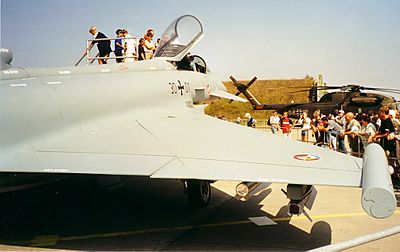
Modern Use
Germany used military aircraft in war for the first time since 1945 when they supported British aircraft in the war in Kosovo in 1999. However, many people still believe that Germany should never go to war again because of what happened in the two world wars.
Images for kids
-
Junkers Ju 87 Ds over the Eastern Front, winter 1943–44
-
Defendants in the dock during the Nuremberg trials. Hermann Göring (left, first row) was a main target.
-
Ruins of Guernica, 1937
See also
 In Spanish: Luftwaffe (Wehrmacht) para niños
In Spanish: Luftwaffe (Wehrmacht) para niños


